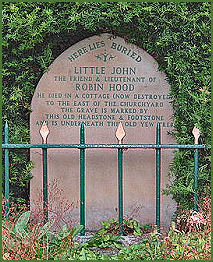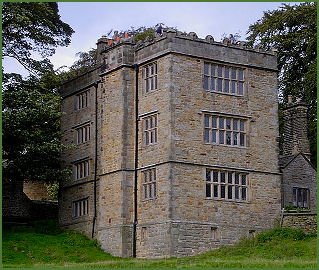Hathersage
OS Grid ref:- SK149665
 The Peak District village of Hathersage lies in the Derwent Valley, around 10 miles to the west of Sheffield.
The Peak District village of Hathersage lies in the Derwent Valley, around 10 miles to the west of Sheffield.
An ancient settlement, Hathersage was recorded in the Domesday Book of 1086 as Hereseige. The name thought to have derived from "heather-edge".
The village, which is set in stunning scenery, is a popular centre for walkers and climbers, on its eastern side the village is overlooked by wild moorland and a line of gritstone edges of which the dramatic Stanage Edge is the largest. Nearby Higger Tor (pictured left) is one of the dominant landmarks of the Dark Peak and rises to a height of 434 metres (1,424 feet). The tor overlooks the iron age hill fort of Carl Wark.
The village church of St. Michael's dates from the late fourteenth and early fifteenth centuries. It boasts a stained glass window by Charles Kempe, which was recovered from Derwent Chapel before it was submerged beneath the Ladybower Reservoir. The base and lower shaft of a Saxon cross stands in the churchyard.
 Also of interest in the churchyard is the curious stone which marks the grave of Little John (pictured right), in 1780 James Shuttleworth and his cousin Walter Stanhope claimed to have unearthed a thigh bone measuring 72.39 cm, which would have made Little John measure 8.08 feet in height, the bone has now been lost. The inscription reads-
Also of interest in the churchyard is the curious stone which marks the grave of Little John (pictured right), in 1780 James Shuttleworth and his cousin Walter Stanhope claimed to have unearthed a thigh bone measuring 72.39 cm, which would have made Little John measure 8.08 feet in height, the bone has now been lost. The inscription reads-
Here lies buried Little John, the friend & lieutenant of Robin Hood. He died in a cottage (now destroyed) to the east of the churchyard. The grave is marked by this old headstone & footstone and is underneath this old yew tree'.
According to legend Little John, after he had buried his comrade Robin Hood at Kirklees Priory, made his way sadly back to Hathersage where he spent his last remaining days. The celebrated English antiquary, Elias Ashmole wrote in 1625 'Little John lyes buried in Hathersage Churchyard within three miles from Castleton, near High Peake, with one stone set up at his head and another at his feete, but a large distance between them.' A number of local landmarks are associated with Robin Hood, such as Robin Hood's Cross on Abney Moor, Robin Hood's Stoop on Offerton Moor, and Robin Hoods Cave, on Stanage Edge.
 A viking earthwork occupies a circular mound next to the church, known as Camp Green, it is thought to be a fortification built by the Danes in around 850 AD.
A viking earthwork occupies a circular mound next to the church, known as Camp Green, it is thought to be a fortification built by the Danes in around 850 AD.
The famous romantic novelist Charlotte Brontė stayed at the Hathersage vicarage in 1845, while visiting her friend Ellen Nussey, whose brother was the vicar. Charlotte arrived to keep Ellen company for a few weeks while her brother was on honeymoon. The Vicarage is a solid, comfortable-looking house and remains much the same as it was in 1845. Many of the locations mentioned in her novel 'Jane Eyre' match locations in Hathersage, the name Eyre being that of a local gentry family. Nesrby Moorseats becomes Moor House in the novel, while Brookfield Manor, a huge ivy-covered mansion, becomes Vale Hall.
'Thornfield Hall', Rochester's home in the novel is widely accepted to be North Lees Hall (left), an imposing tower house and one of the finest Elizabethan buildings in the area, it was once the home of Robert Eyre and is situated on the outskirts of Hathersage. Constructed of coursed rubble gritstone, with mullioned windows, it was built for William Jessop in the early 1590s.
Hathersage has a range of shops including cycle hire shops and outdoor equipment suppliers. There are several pubs and hotels in the village including the sixteenth century George Hotel, the Hathersage Inn and Little John Inn. There is also a superb outdoor swimming pool, which is open to the public during the summer months.
Higher Tor image courtesy of Rob Bendall
Nearby places of interest
The Longshaw Estate, situated on the moors above Hathersage, was once the Duke of Rutland's shooting estate and has been owned by the National Trust since 1931. The estate offers scenic Peak District, views, ancient woodland, parkland and heather moorland.
Stanage Edge is the largest of the gritstone edges in the Peak District National Park and was formed during the last Ice Age, some 10,000 years ago. Once a private grouse moor, it is now a highly popuar location with climbers and walkers.
The Upper Derwent Valley contains some of the most stunning scenery in the Peak District National Park.
